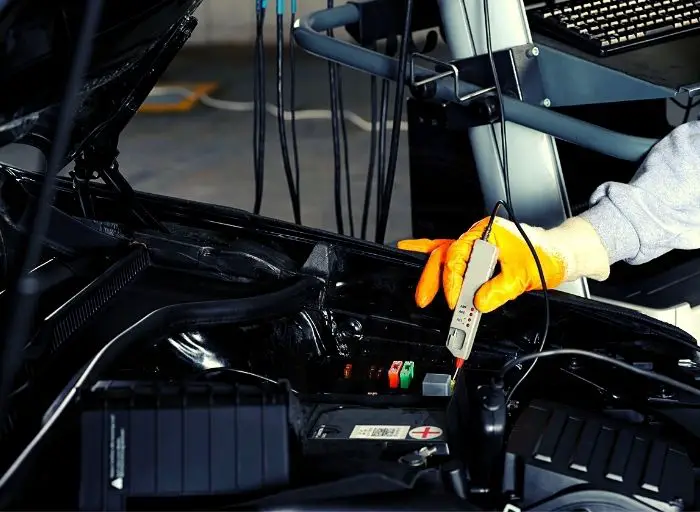
Automotive electrical troubleshooting is a headache for many people. Electrical problems can be frustrating to figure out, but they don’t have to be if you remember these simple rules: Every circuit needs a way to get power, and most electrical devices need a certain minimum voltage to work right. All circuits also need to be “constant.”
So, often these electrical failures are associated with low voltage, too much resistance, or a loss of continuity.
Table of Contents
Automotive Electrical Troubleshooting
Here are some basic troubleshooting techniques:
Checking the voltage for electrical problems in a car
Voltage is another thing that every electrical device needs to work. As the voltage drops, a light bulb will glow with less brightness. But some parts have a minimum voltage level below which won’t work at all. If the battery voltage is low, the starter motor may turn the engine over more slowly. If the battery voltage is too limited, it may not turn over at all. The minimum threshold voltage is especially important for various components such as solenoids, relays, horns, and most electronics.
If you use a voltmeter to check the load point for full battery voltage, you can tell if enough voltage is getting through or not. The battery should be at least 70% charged and have a voltage of 12.43 volts or more. If the battery is low, it should be charged and tested. The charging system’s output should also be checked. It should be 1.5 to 2.0 volts higher than the battery’s base voltage. If the battery is good, your voltmeter should read within 1 volt.
Most of the time, a low circuit voltage is caused by too much resistance somewhere in the wiring. Most of the time, this is caused by a weak or rusted connection, a broken switch or relay, or bad ground. Use the voltmeter to do a voltage test at different points in the circuit. This will help you find the spot with the most resistance. If the voltmeter demonstrates a drop of more than 0.4 volts across any contact, there is a problem. The voltage drop shouldn’t be more than 0.1 volts, if possible.
Do a voltage drop test between the battery terminals and the engine/body ground straps if you find low voltage in more than one circuit. Problems with voltage are often caused by ground straps and battery cables that are loose or rusty.
Low voltage can sometimes be caused by wiring that is too small. It’s not something you’ll find in a lot of the wiring circuits for factory-installed parts, but it’s a classic error that people make when they wire aftermarket parts themselves. The gauge size of the wires needs to be bigger the more amps are being used in the circuit.
Tests for electrical continuity
To function properly, every electrical circuit needs a full circuit. Voltage to the load won’t do any good if there isn’t also a complete path to the battery’s ground. All cars with metal bodies have the body itself as the ground path. In cars with plastic bodies, there needs to be a separate ground wire to connect the load to the chassis. A bad ground connection is the same as an open switch in either case. Since the circuit is not complete, there is no flow of electricity.
To test for wiring continuity, you need to have an ohmmeter or a test light that runs on its own power. A better choice is an ohmmeter, which shows exactly how much resistance there is between any two test points. On the other hand, the test light will shine when there is continuity, but the brightness of the bulb will depend on how much resistance is in the circuit. But it works well for quick checks.
Remember that never use an ohmmeter in a live circuit to check the resistance.
You can use an ohmmeter to measure the resistance of a circuit, but you have to be careful when checking electronic parts. An ohmmeter works by sending a small amount of voltage through its test leads. This voltage can be enough to harm some electronic parts (such as the oxygen sensor). For testing electronics, you should use special 10,000 mega-ohmmeters with a high impedance.
How to Tell if Your Car’s Wiring Has Electrical Problems
Now that we’ve talked about some simple ways to fix problems, what’s the best way to find an electrical problem quickly? It depends on what kind of problem there is.
A broken wire
The first thing to check in a “dead” circuit is the volts at the load point. Check for voltage with the voltmeter or 12-volt test light. If there is voltage, the issue is either a poor ground connection or the element itself.
Poor connections
Bad connections come next. When a connection is loose or corroded, it creates resistance. This resistance causes the voltage to drop, which can hurt other parts of the circuit. A non-powered circuit connection can be checked for too much resistance with an ohmmeter, but a better way would be to get a voltmeter to verify for a voltage drop across the connection.
As was already said, a voltage drop of more than 0.4 volts is bad, and 0.1 volts or less is ideal.
Intermittent issues
A problem with electricity that comes and goes is the hardest to fix. Most of the time, an intermittent open or short is caused by something heating up and breaking (or making) contact, or by something that is loose and making contact from time to time.
Most of the time, this kind of problem is caused by loose or corroded connections and switches. Try moving the wires as well as the circuit switch to see if it changes the voltage or resistance of the circuit. A short can be caused by a wire that is rubbing against something and has lost some of its insulation. Again, this can be found by wiggling the wires in question.
Electrical systems can also be messed up by the environment. Water that leaks through a fracture in the cowl, under the windshield. Look for rust or leaks that are easy to see, and if you don’t find any, check the weather seals nearby.
As a final tip for fixing electrical problems, don’t just twist two wires together and cover electrical tape all around the connection when splicing them. Use a crimp-on connector that doesn’t require soldering, or spin the wires together, solder them, and use electrical insulation tubing with shrink wrap to seal the repair.
Signs Your Car’s Electrical System Is Going Bad
There are many signs that your car’s electrics aren’t working right. Some of the following signs could be caused by something else, but if you notice more than one, it’s usually a good sign that your car’s electrical system isn’t working right.
Blown fuses: If you constantly have to replace blown fuses, this means that something in the power system has sent too much current through those fuses.
Dim car lights: If you’re driving and notice that any of your car’s lights are dim, this can be a red flag with the electrical system, usually a failing alternator. If you ignore it, you might get stuck somewhere.
The engine is hard to turn over: For your engine to start, electricity needs to flow to the spark plugs. Without a strong flow, it will be hard for the engine to start, or it might not start in any way.
Plastic melting: Don’t ignore the smell of plastic melting, because it could mean that your wiring is getting so hot that it’s melting the insulation around it. If you don’t take care of this, it could start a fire in your car, maybe even while you’re driving.
Bad spark plugs: If the spark plugs aren’t getting enough electricity, the fuel in the cylinders won’t burn all the way. Sometimes it’s just one or two spark plugs that aren’t working right, potentially causing the engine to run rough.
No lights, horn, or radio: Something as simple as a blown fuse can cause these problems. But if more than one electrical system stops working, it could mean you need to replace the alternator or something else.
Hi there! I’m Naomi O’Colman. I’ve got years of experience working at an auto repair shop here in Texas under my belt. On top of that, ever since I was a kid I’ve been passionate about the auto industry. Since I’ve joined the team at automotivegearz.com I’ve been enthusiastically sharing my passion and insights with my readers. I’m dedicated to delivering high quality content and helping you stay up to date with the latest automotive trends and products out there!







